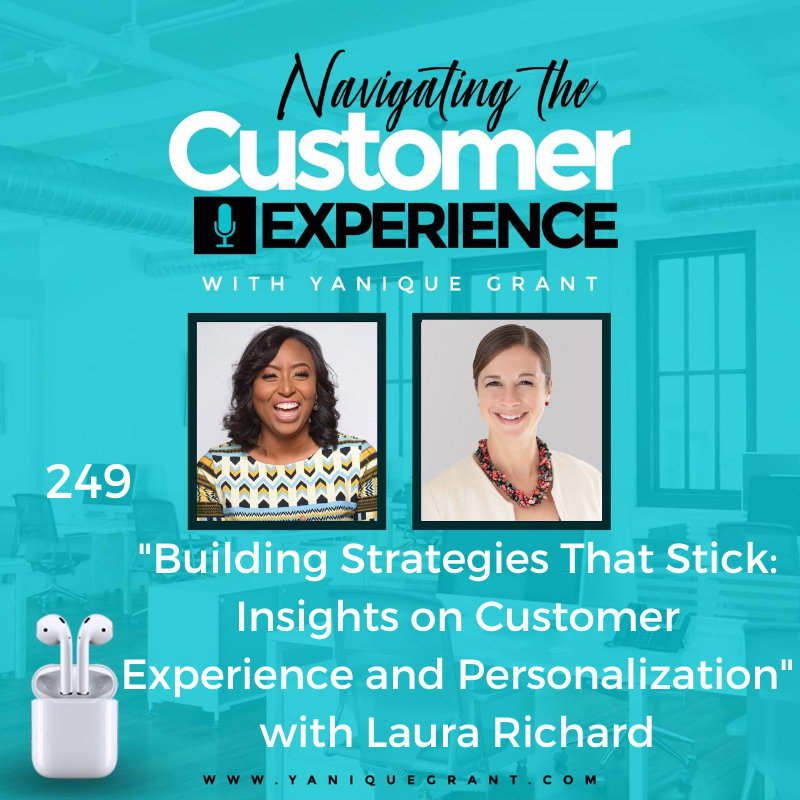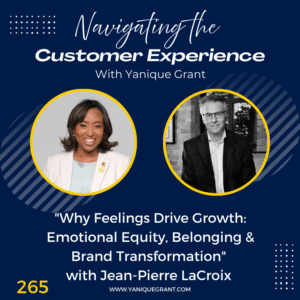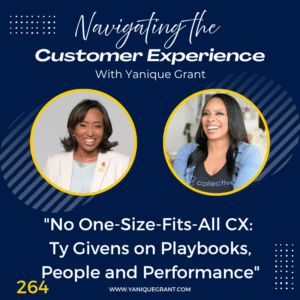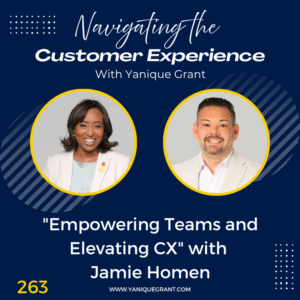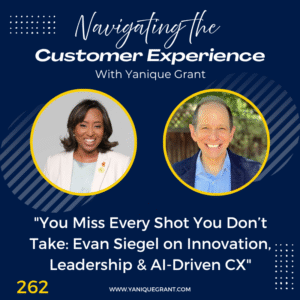Laura Richard as a leader who is deeply committed to understanding the root of the challenges her clients are experiencing, Laura is skilled at connecting the dots between disparate pieces of insight to create clarity and galvanize alignment to a shared vision. Drawing from diverse pieces experiences across public, private and not-for-profit sectors, Laura leverages cross sector insights to inspire her clients in their own growth and transformation journeys.
Laura helps clients to identify the important moments of truth within the customer, advisor and employee experiences, and she designed solutions that will help the business to deliver impact and reinforce their brand promise.
Laura’s background is in health sciences and belief in the importance of physical activity, and it’s leveraging her role as Chair of the Board of ParticipACTION, Canada’s leading advocate for physical activity.
Questions
· Now, I know we read your bio, and it kind of gives our audience a little bit of who you are, but we always like to give our guests an opportunity to share in their own words how you got from where you were to where you are today.
· So, tell us a little bit about navigating the customer experience with some of your customers, just a little bit about how it is that you’re able to help them to achieve that. Because I think at the end of the day, all clients want to have a high level of customer retention.
· How important is personalization in really driving an organization that is customer centric?
· Could you share with our audience maybe one or two, I would say trends, that if they were to choose those maybe key areas that they should focus on for the next 6 to 12 months, what would you say those things need to be?
· Can you also share with our listeners, Laura, what’s the one online resource, tool, website or application that you absolutely can’t live without in your business?
· Can you also share with us maybe one or two books that you’ve read, it could be a book that you read a very long time ago, or even one that you’ve read recently, but it has had a great impact on you, personally or professionally.
· Now, could you also share with our listeners what’s the one thing that’s going on in your life right now that you’re really excited about, either something you’re working on to develop yourself or your people.
· Where can listeners find you online?
· Now, before we wrap our episodes up, we always like to give our guests an opportunity to share with us, maybe a quote or a saying that you have that you will revert to that during times of adversity or challenge, the quote kind of helps you to get back on track. Do you have one of those?
Highlights
Laura’s Journey
Me: Now, I know we read your bio, and it kind of gives our audience a little bit of who you are, but we always like to give our guests an opportunity to share in their own words how you got from where you were to where you are today.
Laura shared that that’s a great question to start off with. So, as read in her bio, she has a health sciences background, so, “How the heck did she become a management consultant?” It’s usually the first question that people ask her, but she thinks it’s actually her curiosity and her desire to experiment, to test things, to understand what works, what doesn’t, that led her from the sciences to a business consulting practice, because they were experimenting and testing and helping clients move from hypothesis to confirmation of solution all the time.
So, over her career, which spans 15 plus years, she started out actually in sport management, sport sponsorship, her interest in solving business problems through partnership is what led her into a broader management consultant practice, and today, she works with clients to help them build strategies that stick and can be implemented and that they will see results from, the results that they’re looking for in their businesses. So, that’s who she is. She’s a Principal at Level5 Strategy, and they are a boutique management consulting firm that is based in Toronto, Canada, but doing work across North America and even some global work.
Navigating the Customer Experience with Clients to Achieve a Level of Customer Retention
Me: So, tell us a little bit about navigating the customer experience with some of your customers, you don’t need to mention any names or anything, but just a little bit about how it is that you’re able to help them to achieve that. Because I think at the end of the day, all clients want to have a high level of customer retention.
Laura shared that the work that she does with clients is to help them understand the true motivators of the desired behaviour that they’re looking to see from customers, so whether that’s purchase or cross sell or loyalty, what really motivates the behaviour of a customer, and that is from all the research that she’s done over her career and all the 50%, it’s roughly 50% what people get from the brand, from the experience, and it’s 50% how they feel as a result of the experiences that they have. And this is true regardless of what industry you’re in.
So, she’s done work in retail, she’s done work in insurance and other financial services sectors. They’ve even done work in B2B and manufacturing. And this consistency with which they see roughly 50% rational and 50% emotional attribution to what motivates people to make decisions and to behave in a certain way is consistent, regardless of what industry you’re talking about.
And so, by understanding what those motivations are, she works with clients to help them craft a compelling promise to their customers, and then to bring that promise to life throughout the customer journey, and so, she’s sure they’re going to dig into to these things more, because she’s said a lot in those few sentences, but they try to help clients identify what are the most important moments along the customer journey? What are the places that they really have to differentiate, that are going to create the most impact for customers are most likely to drive towards the outcome, behaviour that they’re looking for and how they can bring across life in a unique and differentiated way at those moments.
Me: Now, I imagine trying to bring those to life, It’s also trying to resolve any pain points that their clients are having, right? And one of the things you said that I think is so important, I mean, I talk about it in customer service training all the time, is a customer’s feelings towards how you treat them, how the interaction goes, how quickly things are able to be resolved, the information that their getting that plays an great impact, it has a great influence on whether or not they’ll do business with you again. But feelings are so subjective because people are human beings, and based on how we’re socialized and our backgrounds, you and I may go in and have the same interaction with the same individual, but we may walk away with a totally different perspective based on the experience. How do you help them to navigate through those kinds of situations that can be so subjective, and it’s not like there is a cookie cutter recipe that you can just give them to say, okay, just do this and that would be the result.
Laura shared that she’s reminded of some recent work that she’s done with the client where there isn’t a universal answer dealing in this business with many different customer types, everything from an individual to a business, and so the experiences that those two different customer segments are looking for are completely different.
So, how do you create universality in terms of the training, the guidance that you’re providing, especially to your frontline teams? And she thinks it comes back to some simple concepts. It’s really about listening actively to the customer, seeking to really understand where they’re coming from, what’s driving their pain point, or what they’re trying to accomplish with you in that interaction and that you’re listening not to find the solution and lead to the solution, but you’re listening to really build your understanding and demonstrating to them that you are truly listening to them by playing back, by validating what they’re saying to you, by showing that you have empathy for where they’re coming from, and then working with them towards what can I do to help you and leaving them feeling like they have been empathized with. She thinks regardless of whom the customer is, what their challenge is, those are some universal concepts that absolutely apply to any customer situation.
Personalization is Important in Driving an Organization That is Customer Centric
Me: So, in just listening to you now, it also sparked my interest to talk about personalization, because that’s pretty big, right? But if you really want to be a customer centric organization, I shouldn’t feel like what you’re giving me is exactly the same thing that everybody else is going, I shouldn’t feel like another transaction. I must feel like it’s specific to me, it’s customized for me. How important is personalization in really driving an organization that is customer centric?
Laura thinks it’s becoming more and more important as we gain access to the tool, the data, data points can be connected in much more meaningful ways. If the degree of personalization that you provide is going to enhance the relationship that you have with the customer, it’s going to certainly help you in generating the outcomes that you’re looking for, and in making the customer feel the way that you know they need to feel to be receptive to an opportunity with your business.
But she does think with personalization, there’s the risk of trying to do too much, and organizations often boil the ocean or think they have to be all things to everyone. And they overextend themselves, and they go too far, too fast. And so, to her, as we think about personalization, you should really look at the maturity of the business and the readiness to incorporate all the tools and data that we have now access to the business’s maturity to integrate that and to act on it is really important when it comes to what should you do? Where should you start? How far should you go?
Me: Agreed. So, you definitely need to kind of look at it to see if you can scale. And as you said, they’re doing too much too quickly, because at the end of the day, you don’t want to be unsustainable, you’ve started something, customers’ expectations have now adjusted, and you just can’t maintain it.
Laura agreed, that’s right. And it’s challenging for businesses, because customer expectations are set by the best experiences that they’re having with any brand.
They’re not comparing your experience to experience with a competitor, they’re comparing the experience they have with you to the experiences they have through Amazon. And so, that becomes really challenging, and it can feel very daunting, and like you have to do everything, but if you’re not going to have the ability to sustain it, if it’s not going to be actionable and pragmatic for your organization, then it’s wasted investment and it’s wasted resources.
Key Areas That Should be Focused on for the Next 6 to 12 Months (2025)
Me: So, based on the work that you’ve been doing, Laura, could you share with our audience maybe one or two, I would say trends, that if they were to choose those maybe key areas that they should focus on for the next 6 to 12 months, what would you say those things need to be?
Laura shared that that’s a great question. She was at a customer experience conference just a week ago, and this was a big topic of conversation. What do you need to focus on?
She feels like AI is the buzz word that everybody was talking about, we’ve got to focus on AI. But she’s going to actually put a switch to that.
She thinks businesses need to be really focused on understanding across the customer journey, what are customers looking for from them at the touch points that are their moments of truth, or the current pain points in the journey, and how do they best solve for them?
Because with everything coming at you, in terms of AI solutions, new technologies like large language model chatbots, so you don’t even have to send a customer to your call center, you can have them self-serve through the latest and greatest in chatbot. There are all these things coming at them.
What businesses need to do first though is understand what does the customer need at each of those touch points and what type of solution is best to solve?
Because the number of times that she sees businesses just throwing a new technology at something without understanding that root cause of the problem or the need, means they’re not actually solving for frequently. And so, she would say, before launching anything new, really understand what you’re solving for.
The other thing that she thinks is really critical for leaders and customer experience to be focused on is connecting the impact of improvement in customer experience back to business outcomes.
What does one point of NPS mean in terms of your Top Line Revenue or Lifetime Customer Value?
There’s a lot of pressure on customer experience professionals right now, she thinks their scope of role is not attack, but it’s really being pressure. And the partnership between customer experience professionals and the CFOs office has never been more important, and so she would really counsel individuals in this space to be understanding the data between what they’re working on and how it impacts the business result.
Me: That makes sense. So, if the organization, for example, doesn’t currently have that data, like they’re not doing NPS, or they don’t have those metrics to tie back to the business outcome, your recommendation is that’s where they need to start, that’s their focus, right?
Laura agreed that’s where they need to start there and understanding what should your metrics be, and at the end of the day, what metric you choose is actually less important than having something that you measure and having something that you connect leading indicators.
So, things like call handle time, first call resolution, those are your leading indicators that you can say as this goes up or this goes down that results in an increase or decrease to she’ll pick NPS here, and as we see NPS moving up and down, we see our financial measures moving in these directions.
You can also look at it from a cost containment perspective. So, as we see NPS going up in our call center, we’re seeing that we are being much more efficient in our call center, and so we’re saving a lot of money because we’re not having to add a headcount. So, those are the types of real deep analysis moments that allow you to really make the case for the improvements that you want to make in customer experience.
Me: Now, Laura, it’s also important, we mentioned a little bit about the emotional when we spoke earlier that the emotional, what was the other 50% you said?
Laura shared that rational, what you get and how you feel. So, she’ll use an example to bring this to life. You think about an iPhone, why do people say they buy the iPhone?
They are going to tell you all of the gaps, all the rational things, “I love that it has iMessage and so it’s like the blue bubble, I can talk to anybody in any country, and it’s going to be free for me. I don’t have extra text charges because of that iMessage function. The display screen is so fantastic. The camera is amazing.”
They’re going to give you all of the rational reasons why they love their iPhone, but what they can’t often articulate is the emotional side of the coin.
And that other 50% is they love their iPhone because it makes them feel connected. So, that iMessage gives them a feeling of connection with the people in their lives that they love. It makes them feel cool and trendy, that they have the best camera, the coolest display. And so, it’s the feeling side of those motivations that really contribute and are often underappreciated in why customers make decisions.
Me: I agree. I’m an Apple lover, for sure, more than an Android user. But to be honest with you, outside of the frilly stuff, like what you said a while ago, that it’s trending and it keeps you connected. I like the fact that the ecosystem of the devices, you can copy and paste from one device to the next, it kind of cuts down steps and wires, and we’re all about trying to make our lives easier.
Laura agreed, simplify and frictionless. So, it makes you feel smart that you’ve taken the friction out of your life because you are a dedicated Apple user.
App, Website or Tool that Laura Absolutely Can’t Live Without in Her Business
When asked about an online resource that can’t live without in her business, Laura shared that they do a lot of customer experience work, and that involves a lot of journey mapping and journey management, because if you haven’t actually understood and mapped all the touch points in the customer journey, you have no idea what you should be doing and where you should be focusing.
And so, one of the most important tools for her is a great journey management tool, and she loves TheyDo, which is a journey mapping and management product online ecosystem. And it’s something that they use all the time in projects with their clients, and they can use it beyond the time that they’re working with them to monitor, to make improvements, to work with their teams, to build ideas for new solutions, and to assess those ideas and prioritize them. And so, it’s a great tool to be able to manage your journeys.
Books that Have Had the Biggest Impact on Laura
When asked about books that have had an impact, Laura stated that she will go back to one that she read quite a long time ago now, and it’s Simon Sinek, Start with Why: How Great Leaders Inspire Everyone to Take Action. She’s sure it’s probably not the first time that the listeners have heard somebody say that this book had a huge impact on them.
For her, the impact was really the concept of starting with why and starting with purpose at the core of why you do what you do, that was really impactful, and in terms of how she continues to think and counsel clients. She thinks it’s so critical that they articulate why they’re in the business that they’re in, why it’s so critical that they’re solving for these problems, because that’s what gets employees excited and motivated to solve for the day-to-day challenges that they face with customers.
Me: So, basically, the leader needs to be able to articulate why they’re doing what you’re doing, like what purpose, what benefit, what value, and get the team to buy into it.
Laura agreed, absolutely.
What Laura is Really Excited About Now!
Laura shared that something that they’ve been working on for the last number of months is repositioning Level5, the firm that she works at, and she’s really excited about where they’ve landed with that and what they’re going to be doing to share that story with their network, with their clients, in the months to come.
And so, Level5 is a firm that was founded with the philosophy that your brand is your business system, and so the promise that you make to your customers, to your employees, every single thing that you do has the opportunity to either reinforce or erode that promise, and creating value for your brand is the most important thing that you can do.
Now, that has served them well in terms of their position, they believe that to their core, but when they actually to ask clients why they work with them. What they said was, “You help us build strategies that stick and that can be implemented.”
And so, they are building their strategy around this concept of helping organizations create data driven strategy that they can implement and so that will stick, that they will be successful in achieving. And so, she’s really thrilled with the work that they’ve done by listening to their customers, first and foremost, to develop that positioning and soon to launch it to the world.
Me: Great. So, you’re practicing what you preach.
Laura agreed, exactly. Start with your customers.
Where can listeners find Laura online?
LinkedIn – Laura K. Richard
Website – https://level5strategy.com/
https://www.research.net/r/l5cxmaturity
Quote or Saying that During Times of Adversity Laura Uses
When asked about a quote or saying that she tends to revert to, Laura shared that Yanique is putting her on the spot with this one. She thinks it’s for her it’s, “Just keep moving forward.” Take stock of where you’re at and make a plan for what you’re going to do to incrementally create value and drive change. So, just keep moving forward.
Me: Keep moving forward. Okay, love it. Well. Thank you so much, Laura. I really enjoyed this conversation. Level5 Strategy is clearly making waves to make this world a better place and help organizations that they can deliver better experiences for clients. I believe if we all have better experience, then the world can be that just much more caring. People will be more motivated to go out and have interactions, they won’t have negative expectations, they’ll go out with positive expectations, because organizations are really hitting the mark and exceeding what they expect. So, I think it was great and just want to extend our gratitude to you for sharing this information with us.
Please connect with us on X @navigatingcx and also join our Private Facebook Community – Navigating the Customer Experience.
Links
• Start with Why: How Great Leaders Inspire Everyone to Take Action by Simon Sinek
The ABC’s of a Fantastic Customer Experience
Grab the Freebie on Our Website – TOP 10 Online Business Resources for Small Business Owners
Do you want to pivot your online customer experience and build loyalty – get a copy of “The ABC’s of a Fantastic Customer Experience.”
The ABC’s of a Fantastic Customer Experience provides 26 easy to follow steps and techniques that helps your business to achieve success and build brand loyalty.
This Guide to Limitless, Happy and Loyal Customers will help you to strengthen your service delivery, enhance your knowledge and appreciation of the customer experience and provide tips and practical strategies that you can start implementing immediately!
This book will develop your customer service skills and sharpen your attention to detail when serving others.
Master your customer experience and develop those knock your socks off techniques that will lead to lifetime customers. Your customers will only want to work with your business and it will be your brand differentiator. It will lead to recruiters to seek you out by providing practical examples on how to deliver a winning customer service experience!

